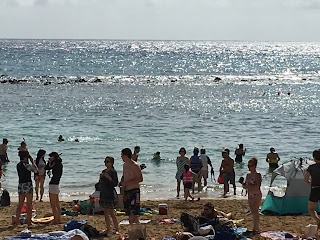Must they drown?
In regards to recent articles and broadcasts regarding drowning deaths, I've submitted the following piece to the Honolulu Star-Advertiser for publication.
Hawaii is a tropical island state, and that means locals and
visitors alike come into contact with the ocean on a regular basis. However, that also means all the dangers
associated with swimming in the ocean exist as well (“Maui waters claim 8
lives,” Jan. 28).
Snorkeling tourists in particular seem to be at high risk
for drowning. At many popular beaches,
lifeguards are available with advice about ocean currents and other hazards,
although sometimes lifeguards don’t seem particularly approachable. These lifeguards aren’t aloof… they are doing
their job, continuously scanning the water for swimmers in distress. Their job isn’t to provide basic snorkeling
instruction to beginners.
So, the visitors from Nebraska or Tokyo, confident that they
can swim because they know they can make it across a 25-meter pool, grab
snorkels, masks, and fins from a rental shop or a tour company, and hit the
beach. There is no one to tell them that
snorkeling is not the same as swimming, that poor swimmers are still poor swimmers
whether or not they have snorkeling gear, and that the place to practice with
new gear is in shallow water in front of a lifeguard stand.
I’m a volunteer at the Hanauma Bay Nature Preserve, and on
the days I am assisting visitors with fish identification in the Hanauma Bay
Marine Life Conservation District, I am also watching people struggle with
their snorkeling equipment. I hear them
ask, “How do I use this equipment?” “How
can I keep my mask from leaking?” I once
saw a man with his snorkel – I kid you not - upside down.
Where do visitors in Hawaii learn about snorkeling? The tour bus driver? Instructions on the gear they just purchased
from Costco or ABC Stores? The rental
shop? It seems there is a missed
opportunity, from a safety perspective, for popular snorkeling beaches like
Hanauma Bay that attract beginners, to have some basic lessons available, a
sort of Snorkeling 101. This can be done
on land or in knee-deep water.
Practicing putting on and adjusting the mask, learning how wet and dry
snorkels work, adjusting the snorkel keeper, discussing defoggers and leak
prevention, and promoting the buddy system for snorkelers are some of the
important topics that could be covered.
It shouldn’t be too hard to get the lifeguards and risk management
specialists together to agree on the topics that can and should be
covered. Likewise, you shouldn’t need to
be a SCUBA instructor or an ocean lifeguard to be able to give an overview of
snorkeling. A skills test for Snorkeling
101 instructors should be enough to winnow the people qualified to perform this
service.
Hawaii is marketed as a snorkeling destination. Box jellyfish, eroding beaches, and sewage
spills aren’t keeping people out of the water.
It seems that providing visitors with a bit of essential knowledge to
keep them safer isn’t too much to ask.
No, it won’t turn a poor swimmer into a good snorkeler, but we should
start with the low-hanging fruit, and give novice snorkelers some essential
information. There are inherent risks
associated with being in the ocean.
People shouldn’t drown because they don’t know how to use their
equipment.
•••
One Hawaii legislator commented, “Here’s the deal,” [Rep.] McKelvey said in an interview Tuesday. “For every negative impression that’s made by a drowning incident, three times the amount of marketing money must be spent to even get a visitor to reconsider Hawaii as a safe place to visit.”










Comments
Post a Comment